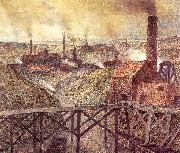Wholesale Oil Painting No Minimum |
|||||||||||
|
|
|||||||||||

|
|||||||||||
|
|
|
||||||||
Meunier, ConstantinBelgian Painter and Sculptor, 1831-1905 Belgian sculptor, painter and draughtsman. He was directed towards an artistic career by his elder brother, the engraver Jean-Baptiste Meunier (1821-1900). He entered the Acad?mie des Beaux-Arts, Brussels, in September 1845 and studied under the sculptor Louis Jehotte (1804-84) from 1848. In addition, in 1852 he attended the private studio of the sculptor Charles-Auguste Fraikin. Gradually he came to feel that sculpture, at least in the traditional form taught in Brussels, was incapable of providing an adequate vehicle for either exposition or expression. Still at the Academy, he transferred to painting, therefore, in 1853, and followed the courses given by Fran?ois-Joseph Navez, studying in the evenings at the Saint-Luc studio, with Charles De Groux. He became friends with Louis Dubois, F?licien Rops and other rebellious young artists who were to found the Soci?t? Libre des Beaux-Arts in Brussels in 1868. With these, Meunier was part of the realist avant-garde, while seeking out a path of his own in painting. It has been said that De Groux had a decisive influence on Meunier. The latter partly denied this and insisted that he had felt the need very early to practise an art that was more devoted to the masses, to the people. His interest in everyday life, in the experience and condition of man, can already be discerned in the sketches and studies he made during his stays in the Trappist monastery of Westmalle, near Antwerp, between 1857 and 1875. |
||||||||
|
|
||||||||
In the Black Country
In the Black Country Painting ID:: 19415 |
1893
Oil on canvas
Mus??e du Orsay, Paris. 1893 Oil on canvas Mus??e du Orsay, Paris. |
|||||||
|
|
||||||||
|
Constantin Meunier (12 April 1831 - 4 April 1905), Belgian painter and sculptor, was born in Etterbeek, Brussels. His first exhibit was a plaster sketch, "The Garland," shown at the Brussels Salon in 1851. Soon afterwards, on the advice of the painter Charles de Groux, he abandoned the chisel for the brush. His first important painting, "The Salle St Roch" (1857), was followed by a series of paintings including "A Trappist Funeral" (1860), "Trappists Ploughing" (1863), in collaboration with Alfred Verwee, "Divine Service at the Monastery of La Trappe" (1871) and episodes of the German Peasants' War (1878). About 1880 he was commissioned to illustrate those parts of Camille Lemonnier's description of Belgium in Le Tour du monde which referred to miners and factory-workers, and produced "In the Factory," "Smithery at Cockerill's," "Melting Steel at the Factory at Seraing" (1882), "Returning from the Pit," and "The Broken Crucible" (1884). In 1882 he was employed by the government to copy Pedro de Campaña's "Descent from the Cross" at Seville, and in Spain he painted such characteristic pictures as "The Cafe Concert," "Procession on Good Friday," and "The Tobacco Factory at Seville" (Brussels Gallery). On his return to Belgium he was appointed professor at the Louvain Academy of Fine Arts. In 1885 he returned to statuary and produced " The Puddler," "The Hammerer" (1886), "Firedamp" (1889, Brussels Gallery), "Ecce Homo" (1891), "The Old Mine-Horse" (1891), "The Mower" (1892), "The Glebe" (1892), the monument to Father Damien at Louvain (1893), "Puddler at the Furnace" (1893), the scheme of decoration for the Botanical Garden of Brussels in collaboration with the sculptor Charles van der Stappen (1893), "The Horse at the Pond," in the square in the north-east quarter of Brussels, and two unfinished works, the "Monument to Labour" and the Zola monument, in collaboration with the French sculptor Alexandre Charpentier. The "Monument to Labour," which was acquired by the State for the Brussels Gallery, comprises four stone bas-reliefs, "Industry," "The Mine," "Harvest," and the "Harbour"; four bronze statues, "The Sower" "The Smith" "The Miner," and the "Ancestor"; and a bronze group, "Maternity". Meunier died at Brussels on 4 April 1905. Constantin Meunier was a freemason, and a member of the lodge Les Amis Philanthropes of the Grand Orient of Belgium in Brussels. He was one of the cofounders of the Societe Libre des Beaux-Arts of Brussels. In 1939, a museum dedicated to him was opened in the last house in which Meunier lived and worked, in Ixelles. Today about 150 of his works are displayed there. In the Black Country 1893 2' 8'' x 3' 1''(81 x 93 cm) |
||||||||
|
|
||||||||
|
Prev Next
|
||||||||
|
|
||||||||
|
Related Paintings to Constantin Meunier :. |
||||||||
|
|
||||||||
|
CONTACT US |

